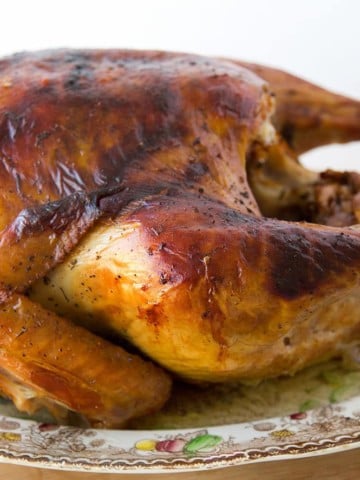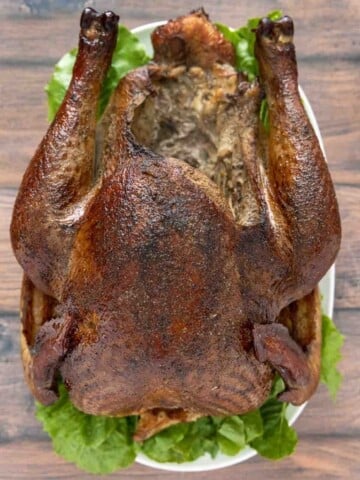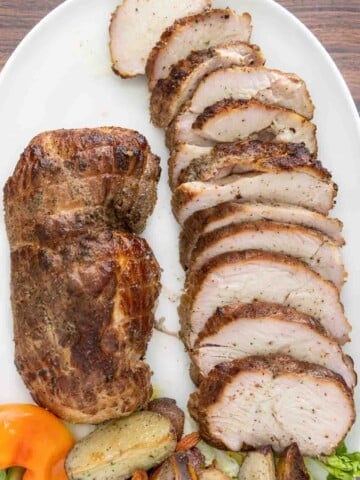If you’re looking for an easy way to add flavor and moisture to your Thanksgiving turkey, look no further; our easy turkey brine recipe is just what you’re looking for.

I guarantee that brining your holiday turkey is going to be a game changer. You’ll never have to serve or eat a dry tasteless turkey again!
When it comes to brining a turkey, you have two options. You can use a dry brine or a wet brine. Both methods are easy to make and will yield a juicy, moist, and flavorful turkey.
In this post, we’re going to show you how to brine a turkey using a wet brine.

This brine recipe is for a 12-14 pound whole turkey, but it can also be used on individual pieces. It can be used to brine turkey breast, thighs, wings, and legs. It can also be scaled down to use on a whole chicken.
If you’re looking for a way to cook your Holiday Turkey faster, make sure to check out our Spatchcocked Turkey recipe. For an alternative to wet brining, try our How to Dry Brine and Roast a Turkey Recipe.
Ingredients to Brine a Turkey

Let’s start by gathering the ingredients we need to make our easy turkey brine recipe. In Chef Speak, this is called the Mise en Place, which translates into Everything in its Place.
Not only does setting your ingredients up ahead of time speed the cooking process, but it also helps ensure you have everything you need to make the dish.
Made with simple ingredients
The best turkey brine recipe contains herbs, aromatics, and seasonings that you and your family enjoy eating. Made with simple pantry ingredients, this recipe can easily be adjusted to suit your taste preferences.
Feel free to use your favorite fresh herbs and seasonings to make the recipe. You can add other citrus fruit, apples, cinnamon sticks, onions, shallots, or other aromatics to this simple brine.
Why should I brine a turkey?
Wet brining a turkey infuses the meat with moisture, helping it to stay moist and juicy during the long roasting process.
During the brining process, the salt breaks down the muscle proteins, allowing the turkey to retain more liquid during the cooking process.
The process adds flavor to the meat and can easily be adjusted to your flavor preferences.
What Type of Container can I use to Brine a Turkey?
We used a Lexan container for the brining process, but you can use a turkey brining bag, large stockpot, 5-gallon bucket, or a cooler. It all depends on how much refrigerator space you have available.
Can I Brine a Frozen Turkey?
Although it’s best to brine a fresh turkey, you can brine a frozen turkey that has been fully defrosted. The problem you may run into with frozen turkeys is that some are injected with a solution that already contains salt.
Brining a turkey that has been injected with a sodium solution can result in a turkey that is too salty. Make sure to check the package to see if it has been injected.
Self-basting turkeys and kosher turkeys have already been injected with salt and seasonings. Some frozen turkeys, and even those listed as “natural” may also have been injected with a sodium solution.
How to Brine a Turkey

- Pour the water, apple juice (or apple cider), brown sugar, and salt into a stock pot and heat over medium-high heat.
- Stir to combine and let the brine cook for 2-3 minutes.
- Add the black pepper, fresh thyme, fresh rosemary, bay leaves, garlic, oranges, and honey to the water and juice mixture. Stir to combine
- Bring the mixture to a boil and cook long enough to dissolve the brown sugar and kosher salt (3-4 minutes). Stir throughout the process.
- Remove the brine from the heat and allow it to fully cool. It will cool faster if you place it in a bowl or the container you will be storing the turkey in.
*Do not add the turkey to a warm brine solution.

- Place your fully thawed turkey, breast side down in the container.
- Add the cooled brine to the container. If there is not enough brine to fully submerge the raw turkey, add more cold water to the container (if possible, it should float). Turn the bird a few times and then leave it breast side down in the brine solution.
- Cover the container and place it in the refrigerator for 16-48 hours.
*The bird needs a minimum of 8 hours in the brine for it to have any effect on the turkey meat. - Remove the brined turkey from the container and pat it dry with paper towels. (Let the turkey come to room temperature before cooking).
*Removing excess moisture from the skin will help get the crispy turkey skin that everyone loves.

Roasting a brined turkey will yield a turkey that has flavorful crispy skin on the outside and moist, tender turkey on the inside. Wouldn’t you like to make this year’s holiday dinner an event to remember?
Leftovers can be used up in my homemade turkey noodle soup recipe.
Recipe FAQ’s
Yes, you can. Using a wet brine will make the bird too salty, the texture can get spongy, and the meat will be tough. A rule of thumb is one hour per pound of turkey.
A 12-14 pound bird should be in a wet brine for no longer than 48 hours.
The rule of thumb is to use 1 gallon of liquid brine for every 10 pounds of turkey. The key is to cover the bird with the brine. If that’s not possible, make sure to place it breastside down in the container.
It can be challenging to find space in your fridge for a container large enough for the process, so be aware and plan ahead so you have room to store the container.
Yes, it does. Salts have different chemical structures, flavor profiles, and dissolvability, which can change the density of the brine.
One tablespoon of Kosher salt is not the same as one tablespoon of table salt. Using a larger crystal salt like Kosher salt is key to getting the water ratio for brine correct. A rule of thumb is one cup of kosher salt for every gallon of water.
Kosher salt is also less salty and contains less sodium than table salt or sea salt, which is why it’s essential to use the right salt.








Adrienne says
If my Turkey has already been “sodium enhancd” , could I just use your brine, but not add thensalt?